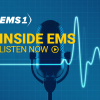Download this quick clip on iTunes, SoundCloud or via RSS feed
In this week’s Inside EMS1 Podcast, hosts Chris Cebollero and Kelly Grayson start off the show on a humorous note, and discuss a story where an Idaho teen crashed after a friend set his armpit hair on fire while he was driving.
“Jokes just write themselves,” Grayson said.
They also take a serious turn and tackle a vote of no confidence from rank-and-file San Francisco firefighters calling for the chief’s resignation. The issue stems from an ambulance shortage, and an inability to meet response time standards.
Grayson also referenced reports that the city has had money to buy 16 new ambulances since 2012, but hasn’t done it yet.
“[The city’s] position seems to be we’re throwing good money after bad, and they’re not using the money wisely,” Grayson said. “Whether that’s true or not remains to be seen.”
They also discuss whether high school students are psychologically and emotionally able to handle the stress of being an EMT. As part of a “put Arizona to work,” mission, students enrolled in the state’s only certified EMS high school program complete the training tuition-free.
“I think, depending on that individual, the answer is yes,” Cebollero said.
Grayson agreed.
I think a highschooler can successfully complete an EMT course and move on to a career in emergency medical services,” he said. “But not just any teenager.”
In the clinical issue, Chris and Kelly are joined by Dr. Peter Antevy, who discusses treating pediatric patients in cardiac arrest.
A lot of it comes down to confidence, Antevy said. When EMTs get to the patient, it can be unnerving to have mom and dad staring at you. But EMTs feel almost energized when responding to adult arrests.
“How could it be that for the adult arrest they feel like Superman but when a pediatric arrest comes along, they kind of feel like Shaggy from Scooby Doo,” he said. “Right then I realized it’s all about knowing the information prior to arrival.”
He suggests using an age-based mechanism rather than a length-based mechanism, and the Handtevy System he created.
He also goes over benefits of treating pediatric patients on-scene rather than doing a rapid transport.
In the adult world, unless you get ROSC, EMS knows that every second that goes by reduces the neurological outcome and survivability, Antevy said. For that reason, many agencies mandate that EMS stay on-scene for 20 minutes.
“Why don’t we do the exact same thing for kids?” Antevy asked. “How come kids don’t get that same exact chance?
Here are links to some of the articles and other items mentioned on the show:


